Throughout the braces treatment process, if oral hygiene is not properly maintained, you may encounter various oral diseases due to plaque accumulation on the brackets and archwires. However, proper care for braced teeth is not simple. This article will guide you on effective braces hygiene, helping you prevent tartar, protect your teeth and gums, and prevent oral diseases throughout the treatment.
How to Effectively and Correctly Clean Your Mouth While Wearing Braces
When wearing braces, oral hygiene becomes more critical than ever. The appliances and brackets create numerous gaps, easily trapping food particles. Cleaning teeth with conventional methods will no longer suffice. Although the braces care routine shares some similarities with pre-braces hygiene, you need to pay attention to the following to ensure a clean and healthy oral cavity:
- Thoroughly clean teeth and appliances: Focus on removing plaque and food debris around the brackets.
- Dietary recommendations for braces: Prioritize soft foods to avoid dislodging brackets. Limit hard and chewy foods.
- Use supplementary oral hygiene products: Incorporate mouthwash and breath spray into your routine to maintain fresh breath.
- Always carry dental wax: This is a “lifesaver” that helps reduce mouth sores and canker sores caused by friction with brackets, effectively preventing them.
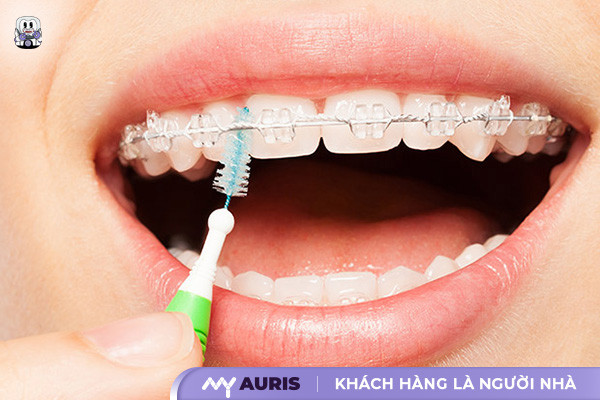
Correct Braces Cleaning Steps for Deep and Safe Cleaning
Proper braces cleaning helps maintain oral health, prevent plaque buildup, protect soft tissues, and avoid inflammation. Below are the expert-recommended standard steps for braces hygiene:
Step 1: Brush Teeth with Proper Technique
Use a soft-bristled toothbrush and fluoride toothpaste, brushing gently in vertical and circular motions. Special attention should be paid to thoroughly cleaning around the brackets, archwires, and other orthodontic appliances.
Step 2: Rinse Mouth to Remove Bacteria
After brushing, rinse thoroughly with clean water, then use a specialized mouthwash to eliminate bacteria and maintain fresh breath.
Step 3: Use a Water Flosser for Deep Cleaning
A water flosser helps remove food debris and bacteria from between teeth, and cleans brackets and archwires more effectively than regular dental floss.
Step 4: Use an Interdental Brush to Clean Bracket Gaps
Use an interdental brush to reach deep into areas that a regular toothbrush cannot, providing optimal cleaning for bracket gaps and archwires.
Step 5: Use Breath Spray
Use breath spray after completing the cleaning steps to boost confidence with long-lasting fresh breath.
Step 6: Use Dental Wax to Protect Soft Tissues
Finally, apply dental wax to the archwire or bracket areas that cause discomfort to prevent friction from harming your gums.
Important Notes on Oral Hygiene During Braces Treatment
Oral hygiene during braces treatment is a crucial factor in maintaining oral health and preventing diseases like tooth decay and periodontitis. If not cared for properly, food debris can easily get trapped in the brackets, creating conditions for bacterial growth and affecting the effectiveness of orthodontic treatment. So, how can you maintain proper oral hygiene? From choosing the right toothbrush, toothpaste, and mouthwash to advanced cleaning methods, let’s explore the details below!
Using a Water Flosser for Effective Braces Cleaning
During braces treatment, a water flosser is an invaluable tool, helping to thoroughly clean tooth surfaces and remove food debris from hard-to-reach areas such as molars 6 and 8. Thanks to its powerful water jet pressure, this device provides comprehensive oral cleaning without harming the gums or affecting the brackets.
However, for optimal braces cleaning effectiveness, you should choose a specialized water flosser designed for orthodontic patients. This device is engineered to protect brackets, minimize the risk of dislodgement, and effectively aid in preventing oral diseases.
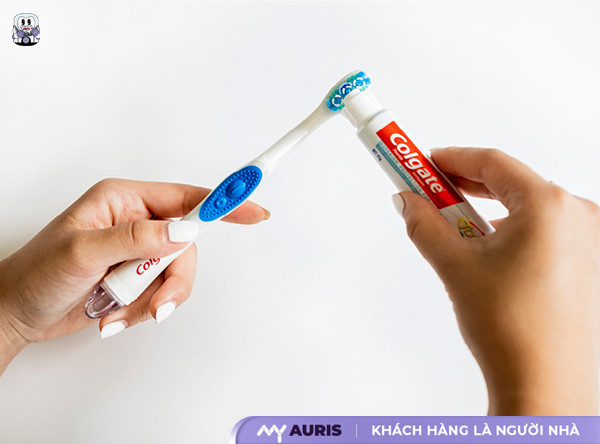
Choosing the Right Toothbrush for Braces
When wearing braces, the appliances in the oral cavity make conventional toothbrushes less effective. Therefore, you should choose specialized toothbrushes such as orthodontic toothbrushes, interdental brushes, or electric toothbrushes to ensure optimal oral hygiene.
Orthodontic Toothbrush (Grooved Brush)
An orthodontic toothbrush (grooved brush) has a design similar to a regular toothbrush but includes a central groove, making it easier to clean brackets and archwires. Additionally, its soft bristles minimize gum damage.
Some suggested orthodontic toothbrush products:
- Colgate Slimsoft Ortho – Approximately 60,000 VND
- Trisa Bracket Clean – Approximately 89,000 VND
- Pesitro 6580 Ultra Soft Ortho – Approximately 100,000 VND
Notes when using an orthodontic toothbrush: Choose a toothbrush with soft bristles to prevent gum bleeding and damage. Use moderate pressure when brushing to clean brackets without dislodging the brace structure.
Interdental Brush
An interdental brush helps remove plaque from the small gaps in brackets and archwires. The brush’s structure includes: A small twisted wire as the main axis. Soft, flexible bristles that can bend, effectively reaching into interdental spaces.
Popular types of interdental brushes:
- Beauty Formulas Active – Approximately 99,000 VND/set
- Piksters – Approximately 122,000 VND/set
- Curaprox Mixed set CPS 150 – Approximately 125,000 – 200,000 VND/set
Two common types of interdental brushes:
- I-shaped type: Used for cleaning front teeth.
- L-shaped type: Features a right-angle design to access back molars.
Notes when using an interdental brush: Choose the appropriate size to easily thread through interdental spaces without harming gum tissue. Avoid using excessive force when scrubbing to protect brackets and archwires. Periodically check the brush head and replace it when bristles become stiff or excessively bent.
Electric Toothbrush
An electric toothbrush is an optimal choice, helping to remove plaque effectively 2 times more than a manual toothbrush.
Design includes: A body containing the power source. A brush head that can be replaced every 3 months.
Outstanding advantages of electric toothbrushes: Deep cleaning with thousands of rapid movements per minute. Multiple cleaning modes, such as teeth whitening and tongue cleaning. A timer mode helps maintain optimal brushing time (2 minutes).
Notes when using an electric toothbrush: Fully charge the battery to ensure cleaning performance. Replace the brush head periodically when bristles are worn or frayed. Brush teeth correctly: Divide your mouth into 4 sections, place the brush at a 45-degree angle to the gumline, and move from the outer teeth inwards. Keep the toothbrush clean and dry after use to extend its lifespan.

Choosing the Right Toothpaste for Braces Wearers
In addition to toothbrushes, toothpaste also plays a crucial role in protecting oral health and orthodontic appliances. Choosing safe, suitable products helps minimize the risks of tooth decay, irritation, and protects teeth throughout the orthodontic treatment. Here are important criteria for choosing the right toothpaste:
Before purchasing, check the toothpaste ingredients to avoid substances that could harm teeth and gums. If unsafe ingredients are found, you should discontinue use immediately.
During braces treatment, teeth become more sensitive. Therefore, prioritize toothpastes that provide a comfortable feeling, ensuring good oral hygiene without causing pain or sensitivity.
Fluoride is a crucial ingredient that helps strengthen tooth enamel, reduce the risk of cavities, and protect orthodontic appliances from plaque. It is an indispensable factor when choosing toothpaste.
Some people may be allergic to certain toothpaste ingredients, leading to nausea, tooth discoloration, or discomfort. If this occurs, stop using it immediately and switch to another type.
Prioritize choosing reputable toothpaste brands with clear ingredients and benefits suitable for braces wearers. Don’t forget to check the expiration date to ensure the best quality.
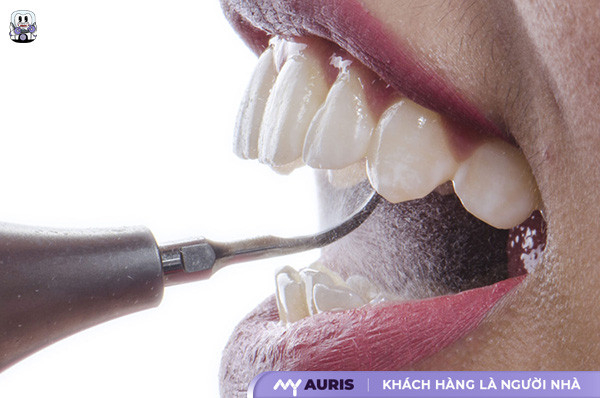
Regular Teeth Scaling
During eating, plaque easily forms at the base of teeth and gums, developing into hard calculus (tartar). Brushing daily alone cannot completely remove calculus, so you need to have your teeth scaled every 6 months. Allowing calculus to accumulate for too long not only affects the aesthetics of your smile but also increases the risk of tooth decay, bad breath, periodontitis, and other oral health issues.
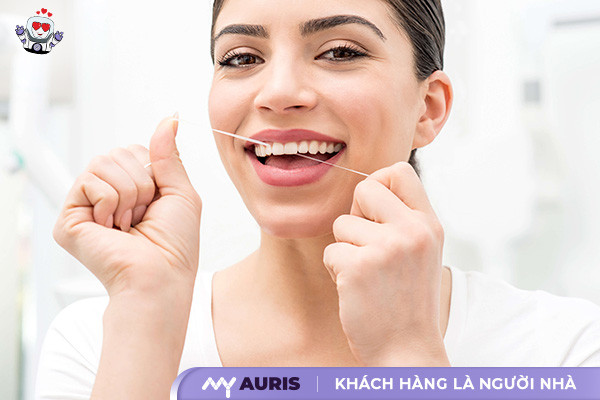
Proper Use of Dental Floss
Dental floss is an important tool in oral hygiene, especially for those wearing braces. This tool helps remove plaque and food debris from between teeth, areas a toothbrush cannot reach. During orthodontic treatment, you should not use toothpicks as they can damage your gums; instead, use dental floss.
How to use dental floss effectively:
- Step 1: Wash your hands thoroughly, cut a piece of dental floss 45cm – 60cm long.
- Step 2: Wrap the floss around your two index fingers, leaving a 4cm section free.
- Step 3: Hold the floss taut with your two index fingers and two thumbs, gently guide it between your teeth.
- Step 4: Move it gently back and forth to remove food and plaque.
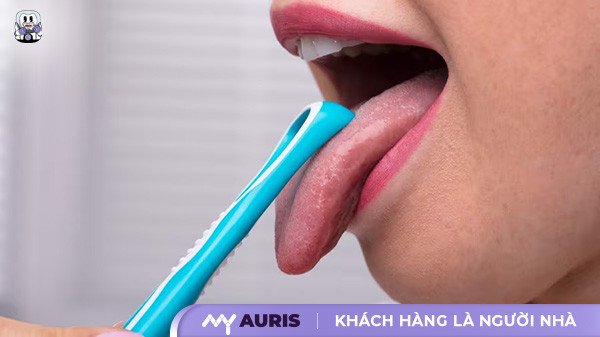
Tongue Scraping
Many people might not be accustomed to tongue scraping, but it is a crucial step in removing bacteria from the oral cavity, especially for those wearing braces. According to research, bacteria primarily accumulate on the tongue’s surface, forming a white tongue coating if not cleaned. This not only affects taste but also causes bad breath. Therefore, using a tongue scraper correctly helps improve oral health and effectively prevents bad breath.
Important notes when tongue scraping:
- Perform before brushing to optimize cleaning effectiveness.
- Scrape gently to avoid damaging taste buds.
- If you’re new to it, you might feel a slight gag reflex, but you’ll get used to it after a few tries.
How to Tongue Scrape Correctly
- Stand in front of a mirror, open your mouth, and stick out your tongue.
- Place the rounded end of the tongue scraper at the back of your tongue.
- Scrape from the back towards the front; do not push from the tip of the tongue backwards.
- After each scrape, wipe the tool with a tissue or rinse with clean water.
- Repeat until the entire tongue surface is completely clean.
- Wash the tool with warm water and soap, dry it, and store it in a clean place.
- This process should take about 2 minutes for best results.
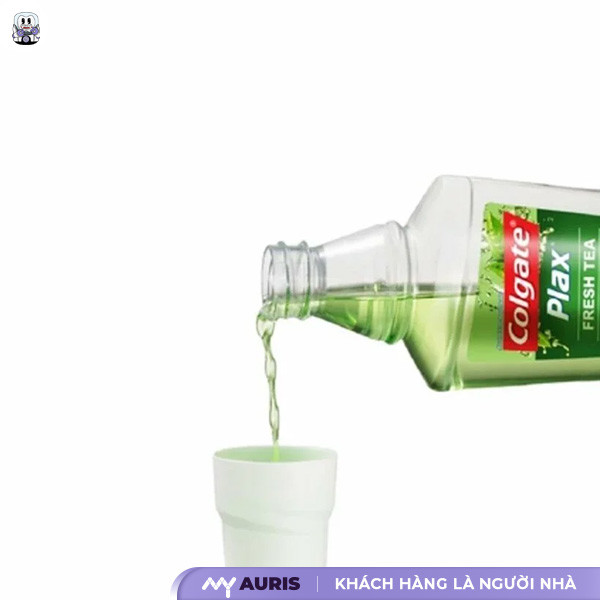
Using Mouthwash
After tongue scraping, the final step is to use mouthwash to eliminate any remaining bacteria in the oral cavity. This is especially important for braces wearers, helping to keep breath fresh and protect teeth and gums from inflammation.
You can choose specialized mouthwashes for braces care, such as:
- Listerine Cool Mint – Price approximately 95,000 VND/bottle.
- Colgate Plax Green Tea – Price approximately 116,000 VND/bottle.
- Vitis Orthodontic – Price approximately 204,000 VND/bottle.
Maintaining proper tongue cleaning habits combined with using mouthwash helps you achieve comprehensive oral health, prevent bad breath, and maintain fresh breath.
We hope that with the shared information, you will master how to use specialized toothbrushes, dental floss, and mouthwash, thereby optimally maintaining your oral health during braces treatment.
You might also be interested in:
📰 Should you drink cold water with braces: Yes or no?
📰 Can you kiss with braces? Great tips for you
📰 5 life-changing motivations for getting braces





